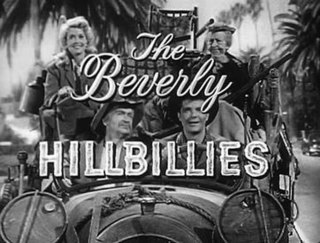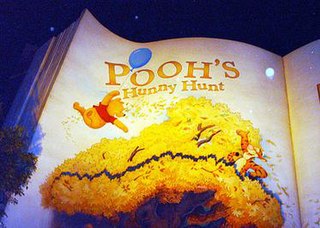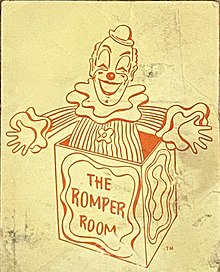
The Beverly Hillbillies is an American television sitcom that was broadcast on CBS from 1962 to 1971. It had an ensemble cast featuring Buddy Ebsen, Irene Ryan, Donna Douglas, and Max Baer Jr. as the Clampetts, a poor, backwoods family from Silver Dollar City in the Ozark Mountains of Missouri, who move to posh Beverly Hills, California, after striking oil on their land. The show was produced by Filmways and was created by Paul Henning. It was followed by two other Henning-inspired "country cousin" series on CBS: Petticoat Junction and its spin-off Green Acres, which reversed the rags-to-riches, country-to-city model of The Beverly Hillbillies.

Captain Kangaroo is an American children's television series that aired weekday mornings on the American television network CBS for 29 years, from 1955 to 1984, making it the longest-running nationally broadcast children's television program of its day. In 1986, the American Program Service integrated some newly produced segments into reruns of past episodes, distributing the newer version of the series to PBS and independent public stations until 1993.
Claster Television, Inc. was a Baltimore, Maryland–based television distributor founded in 1953 by Bertram H. (Bert) Claster and Nancy Claster (Goldman) as Romper Room Inc. It was originally a producer of the children's show Romper Room, one of the first preschool children's programs.

A Hat Full of Sky is a comic fantasy novel by British writer Terry Pratchett, set on the Discworld and written with younger readers in mind. It is labelled a "Story of Discworld" to indicate its status as children's or young adult fiction, unlike most of the books in the Discworld series. First published in 2004, the book is set two years after The Wee Free Men, and features an 11-year-old Tiffany Aching.

Room 222 is an American comedy-drama television series produced by 20th Century Fox Television that aired on ABC for 112 episodes, from September 17, 1969, until January 11, 1974. The show was broadcast on Wednesday evenings at 8:30 (ET) for its first two seasons, before settling into Friday evenings at 9:00, following The Brady Bunch and The Partridge Family, and preceding The Odd Couple and Love, American Style.

Make Way for Ducklings is an American children's picture book written and illustrated by Robert McCloskey. First published in 1941 by the Viking Press, the book centers on a pair of mallards who raise their brood of ducklings on an island in the lagoon in the Boston Public Garden. It won the 1942 Caldecott Medal for McCloskey's illustrations, executed in charcoal then lithographed on zinc plates. As of 2003, the book had sold over two million copies. The book's popularity led to the construction of a statue by Nancy Schön in the Public Garden of the mother duck and her eight ducklings, which is a popular destination for children and adults alike. In 1991, Barbara Bush gave a duplicate of this sculpture to Raisa Gorbacheva as part of the START Treaty, and the work is displayed in Moscow's Novodevichy Park.
{{Infobox television | image = Logo BigComfycouch1992.png | genre = Children's
Educational comedy | camera = Multi-camera | director = Wayne Moss (1992–1995)
Robert Mills (1996–2007)
Derek Ryan (2006)
Steve Wright (2006) | runtime = 25 minutes | creator = Cheryl Wagner | location = Wallace Avenue Studios
Toronto, Ontario (1992–2002)
Studio City
Toronto, Ontario (2006) | presenter = Alyson Court (1992–2004)
Ramona Gilmour-Darling (2006) | starring = Bob Stutt
Fred Stinson
Grindl Kuchirka
Taborah Johnson (1992–1996)
Gary Farmer (1993)
Edward Knuckles (2002-2005)
Robert Mills
Jani Lauzon (1992–1996)
Jackie Harris (1992–1993)
Suzanne Merriam (1994–1996) | theme_music_composer = JP Houston | composer = JP Houston (1992–2004)
Lance Forbes (2005) | country = Canada | language = English
French | executive_producer = Annabel Slaight
Robert Mills | producer = Cheryl Wagner
Robert Mills | editor = Steven B. Pinchuk | company = Radical Sheep Productions
Owl Television (1992–1993)
Owl Communications (1994–1995) | network = YTV (1992–1996)
Treehouse TV (2002–2005) | first_aired = July 15, 1992

Yo Yogi! is an American animated television series and the seventh entry in the Yogi Bear franchise produced by Hanna-Barbera that aired from September 14 to December 7, 1991, on NBC for 13 episodes.

JoJo's Circus is a stop-motion animated television series created by Jim Jinkins, David Campbell, Lisa Jinkins, and Eric Weiner and produced by the Canada-based Cuppa Coffee Studios and Cartoon Pizza. The series was written by Douglas Wood, who previously worked for Tiny Toon Adventures and Animaniacs as a creative executive. The series' songs were composed by Jeffrey Zahn and Jim Latham, with lyrics done by Judy Rothman. The theme song was performed by BECKY.
Adventure Island is an Australian television series for children which screened on the ABC from 11 September 1967 to 22 December 1972. It was jointly created by Godfrey Philipp, who produced the series, and actor-writer John-Michael Howson, who also co-starred in the show. It typically aired from Monday to Friday and each story would stretch across a full week, reaching a resolution on Friday.

Pooh's Hunny Hunt is a unique trackless dark ride located at Tokyo Disneyland. It is based on the 1977 Disney animated film The Many Adventures of Winnie the Pooh.
Betty Thompson (1934–1994) was a Canadian television presenter who spent most of her career at CKCO-TV in Kitchener, Ontario. She was seen throughout Canada as host of CTV's version of Romper Room, a children's programme produced at CKCO's studios.
Mopatop's Shop is a children's television series that which premiered on CITV in the UK on 4 January 1999. 260 ten-minute episodes were made and aired daily. It was a co-production between Jim Henson Television and Carlton Television. After it finished its run in 2005 it was repeated for several years afterwards until 2010.

The Addams Family is an American animated television series produced by Hanna-Barbera Productions and based on the eponymous comic strip characters by Charles Addams. It is the second cartoon show to feature the characters, and ran from September 12, 1992, to November 6, 1993, on ABC. The series' development began in the wake of the successful 1991 Addams Family feature film. Two seasons were produced. It remained part of ABC's Saturday Morning lineup until it was replaced by Fudge in January 1995.

Ding Dong School, billed as "the nursery school of the air", is a half-hour children's TV show which began on WNBQ-TV in Chicago, Illinois a few months before its four-year run on NBC. It is the earliest known preschool series to be produced in the United States, predating Romper Room by a year.
Mr. Cartoon, originally titled Steamboat Bill, was a television program for children that aired for nearly 40 years on WSAZ-TV, the local NBC affiliate in Huntington, West Virginia. The show was hosted by George Lewis until 1969 and by Jule Huffman until 1995. The show ended its run in March 1995; Huffman remained with WSAZ as a weatherman for another three months, ending his career in June of that year.

Jonathan and Darlene Edwards were a musical comedy double act developed by American conductor and arranger Paul Weston, and his wife, singer Jo Stafford. The routine was conceived in the 1950s, and involved Weston playing songs on the piano in unconventional rhythms, while Stafford sang off-key in a high pitched voice. The couple released five albums and one single as the Edwardses, and their 1960 album, Jonathan and Darlene Edwards in Paris won that year's Grammy Award for Best Comedy Album.
Love me Licia is an Italian television series. It is the first of the four live adaptations of the Japanese manga Ai Shite Knight. Its sequels are Licia dolce Licia, Teneramente Licia, and Balliamo e cantiamo con Licia.











